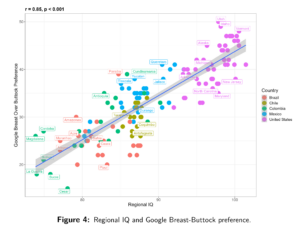Note that perhaps there should be doubt quotation marks around human in the title. Would humans with a 1,000 SD increase in (general) cognitive ability (CA) really be human?
Steve Hsu discusses his rough estimation that we can increase CA in humans around 1,000 SD by basically turning all the current alleles with negative effects into their positive or neutral variants. While the problem seems sound enough to me, I can think of some problems.
Trait level x gene interactions
One problem is the possibility of trait level x gene interactions. For instance, suppose that a large number of genes affect pathway X to CA in a roughly linear fashion (i.e. what we find using familial studies and GCTA methods). This could be brain nerve conduction velocity (BNCV) for which there is some evidence that it is related to CA (TE Reed, AR Jensen, 1993). One seemingly mostly forgotten study did find evidence that the correlation between IQ and NCV is genetic (FV Rijsdijk, DI Boomsma, 1997). There is a physical limit on how fast BNCV can be such that the closer to get the the physical limit, the smaller increase we get from altering another negative allele to its positive version. This would be roughly equivalent to the situation in physics with the speed of light. A given amount of energy converted to kinetic energy will result in a smaller increase in m/s as we get closer to the speed of light (the physical limit).
In the comments, Hsu invokes the history of artificial selection on e.g. oil content to argue against trait level x gene interactions. See also: Animal breeding, human breeding. Brains are much more complicated than simple oil content, tho.
Brain size and BNCV
I seem to recall that due to the relatively low BNCV, there is a limit on the practice size of the brain. We know that brain size correlates with CA around .25 (large meta-analysis), which perhaps after corrections for errors will be .35 (restriction of range and measurement error; see Understanding Statistics). The reason this problem happens is that the internal brain communication will become slower at the brain size increases (brief discussion here), which presumably in the end results in a lower (possibly negative in the long run!) increase in CA from changing the alleles that result in larger brains. Solving this could mean requiring more modularization, which presumably would affect the factor structure of cognitive abilities resulting in a weaker general factor.
Brain size and reproduction
When selecting for one trait one will simultaneously select for a number of other genetically correlated traits. With cognitive ability, one of them is brain size. However, due to the physical limitation on space on women’s wombs, we cannot just scale up the scale of brains indefinitely. The relatively large human head size already results in complications with giving birth in current humans. The birth problem has probably been a relatively strong selective force against higher CA.
We can of course use Cesarians now to avoid between-the-legs birth, so it is not really a problem, but it adds costs to the reproduction process. In the long run, if we scale up brain size a lot, we would need to scale up the size of women’s interior space to accommodate the larger fetus. Note that if we just increase the size of women overall, this would result in smaller brain to brain ratio, which is what really matters. So it won’t be so easy to deal with this problem.
The final (biological reproduction) solution is to stop using women for reproduction: artificial wombs/uterus. This technology is however not being aggressively pursued as far as I know, so it is probably a number of decades away.
Of course, we will want to switch to some other neurate at some point too. :)
